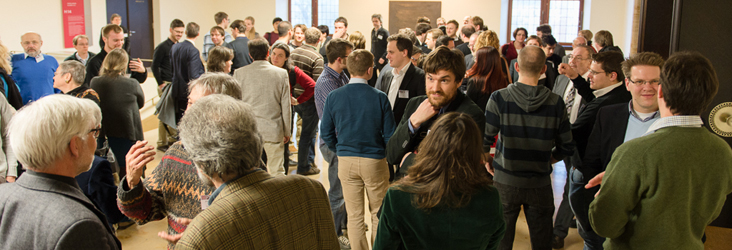
Events 2017
The Interdisciplinary Center for Scientific Computing (IWR) and its affiliated institutions organize a large number of workshops, conferences and other events for discussing latest scientific results as well as identifing upcoming challenges in the field of Scientific Computing. In addition the IWR regularly hosts events which emphasis on broadening and improving the interdisciplinary dialogue.
Talk
"Mixed Finite Element Discretizations for Polyharmonic Equations"
Prof. Mira Schedensack • University of Münster
December 15, 2017 • 11:15
The splitting of poyharmonic equations into lower-order equations is subtle as the obvious splitting requires smoothness of the solution that might not be guaranteed by the elliptic regularity of the underlying PDE. This talk introduces a new splitting based on a Helmholtz-type decomposition. This splitting does only require the natural Sobolev regularity that is given by the weak formulation. The new mixed formulation allows for standard Lagrange ansatz functions of arbitrary polynomial degree. This talk will also state a posteriori error estimates and will illustrate the new method in numerical experiments. Applications include, e.g., the biharmonic problem from plate theory.
Location: Mathematikon • Conference Room / 5th Floor • Im Neuenheimer Feld 205 • 69120 Heidelberg
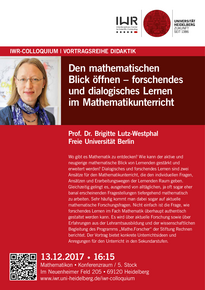
IWR-Colloquium Wintersemester 2017 / 2018 • Vortragsreihe Didaktik
"Den mathematischen Blick öffnen - forschendes und dialogisches Lernen im Mathematikunterricht"
Prof. Dr. Brigitte Lutz-Westphal • Freie Universität Berlin
13. Dezember 2017 • 16:15
Wo gibt es Mathematik zu entdecken? Wie kann der aktive und neugierige mathematische Blick von Lernenden gestärkt und erweitert werden? Dialogisches und forschendes Lernen sind zwei Ansätze für den Mathematikunterricht, die den individuellen Fragen, Ansätzen und Erarbeitungswegen der Lernenden Raum geben. Gleichzeitig gelingt es, ausgehend von alltäglichen, ja oft sogar eher banal erscheinenden Fragestellungen tiefergehend mathematisch zu arbeiten. Sehr häufig kommt man dabei sogar auf aktuelle mathematische Forschungsfragen. Nicht einfach ist die Frage, wie forschendes Lernen im Fach Mathematik überhaupt authentisch gestaltet werden kann. Es wird über aktuelle Forschung sowie über Erfahrungen aus der Lehramtsausbildung und der wissenschaftlichen Begleitung des Programms „Mathe.Forscher“ der Stiftung Rechnen berichtet. Der Vortrag bietet konkrete Unterrichtsideen und Anregungen für den Unterricht in den Sekundarstufen.
Veranstaltungsort: Mathematikon • Konferenzraum / 5. Stock • Im Neuenheimer Feld 205 • 69120 Heidelberg
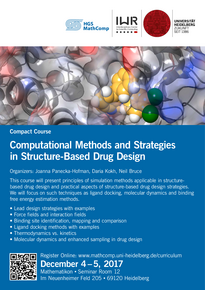
Compact Course
"Computational Methods and Strategies in Structure-Based Drug Design"
Joanna Panecka-Hofman, Daria Kokh, Neil Bruce
December 4-5, 2017
This course will present principles of simulation methods applicable in structure-based drug design
and practical aspects of structure-based drug design strategies. We will focus on such techniques
as ligand docking, molecular dynamics and binding free energy estimation methods.
- Lead design strategies with examples
- Force fields and interaction fields
- Binding site identification, mapping and comparison
- Ligand docking methods with examples
- Thermodynamics vs. kinetics
- Molecular dynamics and enhanced sampling in drug design
!Attention! Limited number of participants, registration required, please register here.
Location: Mathematikon • Seminar Room 12 / 5th Floor • Im Neuenheimer Feld 205 • 69120 Heidelberg
Talk
"The Vlasov-Maxwell Equations for Self-Consistent Electromagnetic Fields - Applications to Mathematical Simulation of Multicomponent Plasmas in a Target Trap"
Prof. Galina Lazareva • Institute of Computational Mathematics and Mathematical Geophysics SB RAS, Russia
December 4, 2017 • 16:00
A plasma target for high neutralization of powerful beams of negative ions is considered. The plasma is held in a magnetic trap with multipole magnetic walls. The inverse of the magnetic tube was proposed to limit the expiration of the plasma through the inlet and outlet ports in the target. Mathematical modeling of plasma dynamics in the trap was performed by the PIC method. The basic idea of the PIC method and new analytical tests for numerical models and codes are presented. Plasma distribution in the trap the efficiency estimate of particle confinement in the magnetic field were obtained. Simulation results were compared with experimental data.
Location: Mathematikon • Conference Room / 5th Floor • Im Neuenheimer Feld 205 • 69120 Heidelberg
Talk
"Invariant Manifolds for the Steady Boltzmann Equation"
Prof. Tai-Ping Liu • Stanford University, USA
December 1, 2017 • 14:15
The global flow picture for the steady Boltzmann equation is studied (jointly with Shih-Hsien Yu). The time-asymptotic analysis is based on explicit construction of the Green's function. For the resonance situation when one of the Euler characteristic speeds is near zero, there are coupling of Knudsen-type and fluid-like waves. The construction of Bifurcation and Sone Manifolds yields finite dimensional reduction of the center manifold. Fluid nonlinearity is recognized and applied to study the global flow picture.
Location: Mathematikon • Seminar Room 8 / 4th Floor • Im Neuenheimer Feld 205 • 69120 Heidelberg
Talk
"Optimal Control of a Body with Movable Internal Masses"
Prof. Felix Chernousko • Ishlinsky Institute for Problems in Mechanics of the Russian Academy of Sciences
November 29, 2017 • 16:15
Motion of mobile robotic systems can be based on specific motions of auxiliary internal masses inside the main body of the robot. Such robots have no outward devices, can be hermetic and operate in various environment, including tubes, vulnerable or hazardous media. Control of rigid bodies by means of internal mobile masses can be useful also for spacecraft. Control of one-dimensional and two-dimensional motions of bodies with internal masses is discussed. Optimal controls for such systems are obtained.
Biography:
Professor Felix Chernousko is a specialist in optimal control, mechanics and robotics. He graduated from Moscow Institute of Physics and Technology and has been working at the Institute for Problems of Mechanics of the Russian Academy of Sciences in Moscow for many years. He had been the director of this institute from 2004 until 2015. Professor Chernousko has published more than 500 papers and 14 books on mechanics of spacecraft, optimal control and robotics. His last book was published by Springer in 2017. Chernousko is a Full Member of the Russian Academy of Sciences, the European Academy of Sciences, the International Academy of Astronautics, Fellow of the European Mechanics Society, Honorary Professor of the Moscow Institute of Physics and Technology and others. He is laureate of the Russian State Prize for Science (twice), the Körber European Science Prize, the Alexander von Humboldt Research Award, the Chaplygin Gold Medal of the Russian Academy of Sciences, the Euler Gold Medal and others. His recent publications are devoted to mobile robots.
Location: Mathematikon • Conference Room (5/104), 5th Floor • Im Neuenheimer Feld 205 • 69120 Heidelberg
Short Course
"20 Years Bromine Explosion - Atmospheric Chemistry in the Polar Troposphere"
Prof. Ulrich Platt & Prof. Eva Gutheil
November 23-24, 2017
The short course concerns different aspects of the bromine explosion in the polar troposphere, which is associated with the ozone depletion in the polar spring. Both numerical simulations of the auto-catalytic chemical reaction mechanism as well as observations in field campaigns are addressed. The short course provides fundamental information on the physical and chemical processes involved. Moreover, the current status of research in this area as well as future research is emphasized.
Location: Mathematikon • Conference Room (5/104), 5th Floor • Im Neuenheimer Feld 205 • 69120 Heidelberg
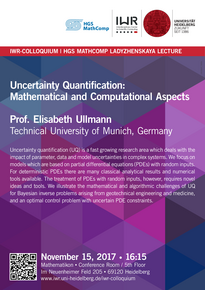
IWR Colloquium Winter Term 2017 / 2018
"Uncertainty Quantification: Mathematical and Computational Aspects"
Prof. Elisabeth Ullmann • Technical University of Munich
November 15, 2017 • 16:15
Uncertainty quantification (UQ) is a fast growing research area which deals with the impact of parameter, data and model uncertainties in complex systems. We focus on models which are based on partial differential equations (PDEs) with random inputs. For deterministic PDEs there are many classical analytical results and numerical tools available. The treatment of PDEs with random inputs, however, requires novel ideas and tools. We illustrate the mathematical and algorithmic challenges of UQ for Bayesian inverse problems arising from geotechnical engineering and medicine, and an optimal control problem with uncertain PDE constraints.
This talk is also part of the HGS MathComp Ladyzhenskaya Lecture Series.
Location: Mathematikon • Conference Room / 5th Floor • Im Neuenheimer Feld 205 • 69120 Heidelberg
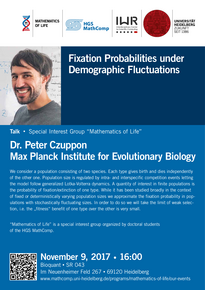
Talk / Special Interest Group “Mathematics of Life”
"Fixation Probabilities under Demographic Fluctuations"
Dr. Peter Czuppon • Max Planck Institute for Evolutionary Biology
November 9, 2017 • 16:00
We consider a population consisting of two species. Each type gives birth and dies independently of the other one. Population size is regulated by intra- and interspecific competition events letting the model follow generalized Lotka-Volterra dynamics. A quantity of interest in finite populations is the probability of fixation/extinction of one type. While it has been studied broadly in the context of fixed or deterministically varying population sizes we approximate the fixation probability in populations with stochastically fluctuating sizes. In order to do so we will take the limit of weak selection, i.e. the "fitness" benefit of one type over the other is very small.
“Mathematics of Life” is a special interest group organized by doctoral students of the HGS MathComp.
Location: Bioquant • SR 043 • Im Neuenheimer Feld 267 • 69120 Heidelberg
66. Heidelberger Bildverarbeitungsforum
"Mensch-Maschine Interaktion mit Vision"
10. Oktober 2017 • Freiburg
Da Vision-Technologien immer besser die dreidimensionale Umwelt des Menschen einschließlich der Dynamik der Szenen erfassen können und gleichzeitig die Hardwarekomponenten leistungsfähiger und energieeffizienter werden, erschließen sich viele neue Applikationsfelder von der Kooperation von Robotern mit Menschen im Produktionsprozess bis zu vielen alltäglichen Tätigkeiten wie die Bedienung von Rechnern, Restaurantbesuch und Einkaufen.
Das 66. Heidelberger Bildverarbeitungsforum mit dem Schwerpunktthema „Mensch-Maschine Interaktion mit Vision“ gibt einen systematischen Einblick in die Anwendungsfelder, in den Vision-Technologien zur Interaktion mit dem Menschen eingesetzt werden können. Gleichzeitig werden alternative Techniken wie Akustik und Radar vergleichend dargestellt. Erstmals endet das Forum mit einer Abschlussdiskussion, bei der alle Referenten zusammen mit den Teilnehmern versuchen, ein Fazit zu ziehen, wie Vision-Technologien heute zu bewerten sind und was sie in naher Zukunft leisten könnten.
Die Mittags- und Kaffeepause geben ausreichend Zeit für praktische Demonstrationen mit zum Inhalt des Forums passenden Exponaten in der Ausstellung, zur Diskussion der Posterbeiträge und für informative Gespräche unter den Teilnehmern und mit den Referenten. Durch die Möglichkeit die Exponate oder Poster mit einem Kurzvortrag („Teaser“ mit zwei Folie und einer Minute Redezeit) vor der Mittagspause vorzustellen und die ausgedehnte Mittags- und Kaffeepause, erhält dieser Programmteil ein ihm gebührendes Gewicht. Die Teilnahme an der Industrieausstellung ist für registrierte Teilnehmer kostenfrei (max. ein Tisch mit Stromanschluss).
Veranstaltungsort: Technische Fakultät Albert-Ludwigs-Universität Freiburg • Georges-Köhler-Allee 101 • 79110 Freiburg

IWR School
"Mathematical Methods for Quantum Chemistry"
October 2-6, 2017 • Heidelberg, Germany
The IWR school 2017 "Mathematical Methods for Quantum Chemistry" targets young researchers from both the field of mathematics and of computational chemistry. Starting with formal basic introductions into both fields to level the ground and introduce the leading concepts and models, the school quickly turns to key aspects of computational quantum chemistry. It analyzes the structure of the underlying eigenvalue problems and outlines and describes in detail numerical concepts of modern algorithmic approaches to deal with these problems in an efficient and error-controlled way. It then turns to basis set representations to open the view into the interplay between mathematical representation, computational treatment and research in quantum chemistry. The theoretical lectures are complemented by hands-on sessions to enable practitioners to make use of modern computation facilities for fast solution of large problems.
The training program is taught in a series of short courses by:
- Eric Cancès, Ecole des Ponts Paris Tech and INRIA Paris
- Denis Davydov, FAU Erlangen-Nürnberg
- Andreas Dreuw, Heidelberg University
- Guido Kanschat, Heidelberg University
- Katharina Kormann, Max Planck Institute for Plasma Physics
- Reinhold Schneider, TU Berlin
Location: Mathematikon • Im Neuenheimer Feld 205 · 69120 Heidelberg
Talk
"Some recent results in Quantum Turbulence"
Prof. Andrew Baggaley • Newcastle University, UK
September 28, 2017 • 15:00
The term quantum turbulence denotes the turbulent motion of quantum fluids, systems such as superfluid helium and atomic Bose–Einstein condensates, which are characterized by quantized vorticity, superfluidity, and, at finite temperatures, two-fluid behaviour. In this talk we shall describe different regimes of quantum turbulence and how it compares to turbulence in a classical fluid. We shall close by discussing turbulence in a quantum analogue of a ferrofluid.
Location: Mathematikon • Conference Room (5/104) / 5th Floor • Im Neuenheimer Feld 205 • 69120 Heidelberg
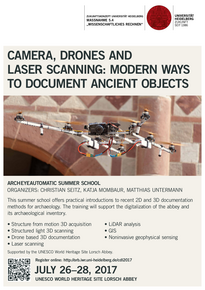
ZUK 5.4
ArchEyeAutomatic Summer School 2017: "Cameras, Drones, and Laser scanning - Modern ways to document ancient objects"
Christian Seitz • Katja Mombaur • Matthias Untermann
July 26-28, 2017
Digital documentation and preservation is a key knowledge for archaeologists, no matter in which research area they are working in. This summer school gives a short introduction in the main digital methods currently used along with practical experience in real environments producing real data. The methods we want to show you are broad:
- Structure from motion: This method uses a series of images to create 3D models. Can be used for small finds to whole buildings (with drones)
- Drones: With drones, Structure from motion can acquire whole buildings or even landscapes. Several methods, from fixed wing (small airplanes) to multirotor drones will be shown.
- Laser scanning: This device can create high precision point clouds in very short time and is very useful for all kind of documentation tasks.
- Structured light scanner: This device is especially suited for small finds and objects. It projects actively light on the object to detect surfaces. The precision and quality is very high.
- David scanner: A low-budget version of the Structured Light Scanner using laser beams. The results are very good.
- Ground Penetrating Radar: Makes structures in the earth visible without excavating. One of the so called “non invasive methods”
- Analysis of airborne LiDAR: Covering large areas, airborne LiDAR can help to detect a lot of archaeological remains, even in forested areas.
- Geographic Information Systems: With the help of Geographic information systems, the analysis of historic movements, distribution systems and many more became possible.
Further inquiries: cdl2017@iwr.uni-heidelberg.de
Location: UNESCO-Welterbe Kloster Lorsch • Nibelungenstraße 32 • 64653 Lorsch
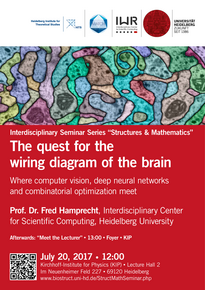
Interdisciplinary Seminar Series "Structures & Mathematics"
"The quest for the wiring diagram of the brain - Where computer vision, deep neural networks and combinatorial optimization meet"
Prof. Fred Hamprecht • Heidelberg University
July 20, 2017 • 12:00
Understanding the brain is an old and yet-unsolved problem. To understand the workings of a neural circuit, it is possibly required to know its structure, and almost surely necessary to know its connectivity.
After great progress in electron microscopy, several labs worldwide are milling away at animal brains and generating what will amount to petabytes of high-quality data. The resulting images are good enough for human tracers to consistently follow at least the majority of neural processes; unfortunately, humans would take thousands of years to complete the task for even the smallest mammalian brain.
So the quest is on for computer vision algorithms to do the same automatically and reliably. The current state of the art pipelines recur to deep neural networks and combinatorial graph partitioning problems. The former are notoriously ill understood, the latter still expensive to solve at scale.
In this talk, I will sketch the problem, a state of the art approach (which does not quite achieve human accuracy yet), and I will lay out some of the open problems in the field.
Interdisciplinary Seminar Series "Structures & Mathematics":
The workshop-seminars aim at initiating interactions between mathematicians and researchers from other sciences. We want to explore in particular questions and problems, which might be of interest to and benefit from the involvement of mathematicians of all sort. The setting of the seminar is informal, and interactive.
Link: Homepage "Structures & Mathematics"
Location: Kirchhoff-Institute for Physics • Lecture Hall 2 • Im Neuenheimer Feld 227 • 69120 Heidelberg
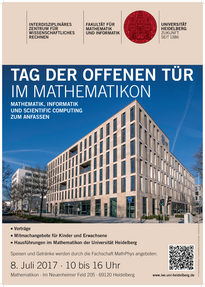
Tag der Offenen Tür
"Mathematik, Informatik und Scientific Computing zum Anfassen"
IWR & Fakultät für Mathematik und Informatik
8. Juli 2017 • 10:00 bis 16:00 Uhr
Am 8. Juli laden die Fakultät für Mathematik & Informatik und das Interdisziplinäre Zentrum für Wissenschaftliches Rechnen (IWR) gemeinsam zum Tag der Offenen Tür im Mathematikon der Universität Heidelberg ein. Von Mathematik zum Anfassen über Forschung zu Künstlicher Intelligenz bis zum Robotiklehrlabor - Wissenschaftler geben spannende Einblicke in die Forschung und Praxis rund um Mathematik, Informatik und Scientific Computing. Führungen durch eines der neuesten Gebäude der Universität Heidelberg ergänzen das abwechslungsreiche Programm.Eine Auswahl an Speisen und Getränken wird durch die Fachschaft MathPhys angeboten.Der Eintritt ist frei.
Veranstaltungsort: Mathematikon • Im Neuenheimer Feld 205 • 69120 Heidelberg
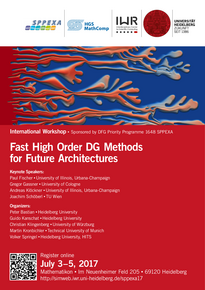
International Workshop
"Fast High Order DG Methods for Future Architectures"
Sponsored by DFG Priority Programme 1648 SPPEXA
July 3-5, 2017
The joint workshop of the EXA-DUNE, EXAMAG and ExaDG projects, being part of the DFG Priority Programme Software for Exascale Computing (SPPEXA), will take place at the Mathematikon in Heidelberg, Germany. The event will be hosted collaboratively by the Heidelberg Institute for Theoretical Studies (HITS) and Heidelberg University's Interdisciplinary Center for Scientific Computing (IWR).The workshop provides a discussion venue for mathematical and algorithmic problems arising when implementing fast, parallel solvers for high-order DG discretizations of PDE problems. Key aspects are
- considering how to exploit tensorial structures to reduce the complexity of local cell and face integral evaluation within a matrix-free based code,
- using algebraic multigrid methods in a computationally intensive framework,
- an implementation of efficient cell- and patch-based smoothers for geometric multigrid methods applicable in a massively parallel environment,
- data locality and
- heterogeneous parallelism, e.g. as when computing boundary and volume integrals simultaneously.
In particular, the algorithms above and mathematical models are discussed with regard to their enhancement of performance and scalability by employing hybrid parallelization techniques, namely multithreading and message passing, combined with low-level optimizations that make full use of vector instructions and device accelerators.
Location: Mathematikon • Im Neuenheimer Feld 205 • 69120 Heidelberg
Talk
"Hyperbolic Approximation of the Vlasov equation and Kinetic approximation of non-linear hyperbolic systems"
Laurent Navoret • University of Strasbourg, France
June 29, 2017 • 16:15
In this talk, we will give an overview of different numerical methods we propose to carry out efficient numerical simulations of the kinetic Vlasov equation and for non-linear hyperbolic equations. The Vlasov equation is a kinetic transport equation in the position-velocity phase space. The numerical resolution of the Vlasov equation requires large computational resources combined with high accuracy for capturing the small scale dynamics (phase-space filamentation, gyrokinetic turbulence). By performing a finite-element semi-discretization in the velocity variable, we approximate the Vlasov equation by a hyperbolic system. Applying mass-lumping techniques on the resulting system, the approximate Vlasov equation reduces to several coupled transport equations. We consider either semi-Lagrangian method on Cartesian meshes or Galerkin-Discontinuous solver on multi-patch structured meshes to achieve high order accuracy in space. As an inverse strategy, we approximate non-linear hyperbolic equations by linear kinetic transport equations with a finite set of velocities and stiff relaxation (Lattice Boltzmann Method). Implicit resolution of the transport equations (by front tracking), combined with palindromic composition method in time (of order 2, 4 or 6) enables us to use large CFL numbers while being well adapted to parallelization.
In this talk I will give a basic introduction to multilevel Monte Carlo methods applied to uncertainty quantification problems in PDE applications. I will aim the talk at numerical analysts and computational scientists, familiar with numerical methods for partial differential equations. I will only assume basic knowledge of probability theory. A particular focus will be the study of the inverse problem, where PDE models with random coefficients that encapsulate the prior knowledge about the coefficient distribution are coupled with measurement data of functionals of the PDE solution. The talk will focus mainly on methodology, but I will refer to some theoretical results that underpin the new methods, as well as stress some open theoretical and computational problems.
Location: Mathematikon • Seminar Room 11 • Im Neuenheimer Feld 205 • 69120 Heidelberg

13. Modellierungstag Rhein-Neckar
"Stadt, Technik, Natur - Am Anfang steht das Modell"
22. Juni 2017 • 14:00 Uhr
Moderne Infrastruktur bestimmt unser Leben und beeinflusst in entscheidender Weise Arbeitsprozesse. Der Industriestandort Deutschland profitiert von seiner idealen Lage im Herzen Europas ebenso wie von Verfügbarkeit und Erreichbarkeit, von Netzkapazitäten oder stadtnahen Produktionsflächen.Unsere Städte spielen in dieser Konstellation eine bedeutende Rolle und ihr Funktionieren hängt maßgeblich von modellbasierter Planung in allen Bereichen ab: Stadtentwicklung, Straßenbau, intelligente Vernetzung und Breitbandversorgung. Diese komplexen Prozesse basieren auf individuellen Modellen, um Systemkomponenten zu erfassen, ihre Veränderung anhand von Simulationen zu planen und Abläufe zu optimieren.Die Stellung Deutschlands als Wirtschaftsstandort erfolgreicher Industrieunternehmen und als Lebensmittelpunkt von über 80 Millionen Menschen hängt vom effizienten, exakten und adäquaten Einsatz moderner Modelle ab. Im Wettbewerb der Besten bietet das den vielleicht entscheidenden Standortvorteil für deutsche Unternehmen – gerade auch im Bereich der KMUs, die seit vielen Jahren vom Funktionieren dieser Infrastruktur international profitieren.Alle Prozesse rund um die Planung in Stadt und Land sind das Thema des 13. Modellierungstags. Gemeinsam besprechen wir neueste Trends aus der Praxis, schauen den planerisch tätigen Wissenschaftlern über die Schulter und diskutieren die Entwicklungen von morgen.
Die Veranstaltung ist öffentlich. Die Teilnahme ist kostenfrei. Um Anmeldung unter www.modellierungstag.de wird gebeten.
Veranstaltungsort: Mathematikon • Konferenzraum (5. Stock) • Im Neuenheimer Feld 205 • 69120 Heidelberg

IWR-Colloquium Summer Term 2017
"What is Non-Linear Preconditioning?"
Prof. Martin Gander • University of Geneva (UNIGE), Switzerland
June 21, 2017 • 14:15
The idea of preconditioning iterative methods for the solution of linear systems goes back to Jacobi (1845), who used rotations to obtain a system with more diagonal dominance, before he applied what is now called Jacobi’s method. The preconditioning of linear systems for their solution by Krylov methods has become a major field of research over the past decades, and there are two main approaches for constructing preconditioners: either one has very good intuition and can propose directly a preconditioner which leads to a favorable spectrum of the preconditioned system, or one uses the splitting matrix of an effective stationary iterative method like multigrid or domain decomposition as the preconditioner.
Much less is known about the preconditioning of non-linear systems of equations. The standard iterative solver in that case is Newton's method (1671) or a variant thereof, but what would it mean to precondition the non-linear problem? An important contribution in this field is ASPIN (Additive Schwarz Preconditioned Inexact Newton) by Cai and Keyes (2002), where the authors use their intuition about domain decomposition methods to propose a transformation of the non-linear equations before solving them by an inexact Newton method. Using the relation between stationary iterative methods and preconditioning for linear systems, we show in this presentation how one can systematically obtain a non-linear preconditioner from classical fixed point iterations, and present as an example a new two level non-linear preconditioner called RASPEN (Restricted Additive Schwarz Preconditioned Exact Newton) with substantially improved convergence properties compared to ASPIN.
Location: Mathematikon • Conference Room / 5th Floor • Im Neuenheimer Feld 205 • 69120 Heidelberg
Talk
"Scholarship in the new age: Integrating research and professional development"
Professor Xiao-Li Meng • Havard University, USA
June 12, 2017 • 11:00
With significantly increased number of graduate students entering career paths beyond academia, there is a pressing need to provide our students with a broad set of skills, in addition to their scholarly training. We enhance our students’ breadth and depth via intergenerational learning and professional development. Professor Meng will demonstrate these by discussing the formulation of, as well as his teaching experience in, Graduate Seminar in Undergraduate Education, the Harvard Horizons Program for communicating Ph.D research findings to general audiences, and the Center for Writing and Communicating Ideas.
Location: Mathematikon • Conference Room / 5th Floor • Im Neuenheimer Feld 205 • 69120 Heidelberg
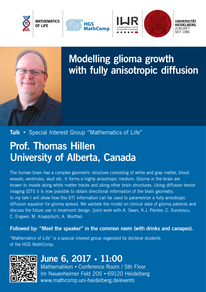
Talk / Special Interest Group “Mathematics of Life”
"Modelling glioma growth with fully anisotropic diffusion"
Prof. Thomas Hillen • University of Alberta, Canada
June 6, 2017 • 11:00
The human brain has a complex geometric structure consisting of white and gray matter, blood vessels, ventricles, skull etc. It forms a highly anisotropic medium. Glioma in the brain are known to invade along white matter tracks and along other brain structures. Using diffusion tensor imaging (DTI) it is now possible to obtain directional information of the brain geometry. In my talk I will show how this DTI information can be used to parametrize a fully anisotropic diffusion equation for glioma spread. We validate the model on clinical data of glioma patients and discuss the future use in treatment design. (joint work with A. Swan, K.J. Painter, C. Surulescu, C. Engwer, M. Knappitsch, A. Murtha).
Followed by: “Meet the speaker” in the common room (with drinks and canapes)
“Mathematics of Life” is a special interest group organized by doctoral students of the HGS MathComp.
Location: Mathematikon • Conference Room / 5th Floor • Im Neuenheimer Feld 205 • 69120 Heidelberg
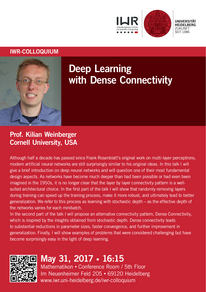
IWR-Colloquium Summer Term 2017
"Deep Learning with Dense Connectivity"
Prof. Kilian Weinberger • Cornell University, USA
May 31, 2017 • 16:15
Although half a decade has passed since Frank Rosenblatt’s original work on multi-layer perceptrons, modern artificial neural networks are still surprisingly similar to his original ideas. In this talk I will give a brief introduction on deep neural networks and will question one of their most fundamental design aspects. As networks have become much deeper than had been possible or had even been imagined in the 1950s, it is no longer clear that the layer by layer connectivity pattern is a well-suited architectural choice.
In the first part of the talk I will show that randomly removing layers during training can speed up the training process, make it more robust, and ultimately lead to better generalization. We refer to this process as learning with stochastic depth -- as the effective depth of the networks varies for each minibatch.
In the second part of the talk I will propose an alternative connectivity pattern, Dense Connectivity, which is inspired by the insights obtained from stochastic depth. Dense connectivity leads to substantial reductions in parameter sizes, faster convergence, and further improvement in generalization. Finally, I will show examples of problems that were considered challenging but have become surprisingly easy in the light of deep learning.
Location: Mathematikon • Conference Room / 5th Floor • Im Neuenheimer Feld 205 • 69120 Heidelberg
Talk
"Massively parallel radiation transport simulations - Current status and challenges ahead"
Prof. Jean Ragusa • Texas A&M University, USA
May 18, 2017 • 16:15
In this talk, I will provide an overview of solution techniques and iterative techniques employed to solve the first-order form of the radiation transport equation on massively parallel machines. A review of scaling efficiency for transport sweeps (up to order 1-million processes) will be provided for logically Cartesian grids. Challenges posed by the need to move to unstructured (load-unbalanced) grids and ongoing research will be discussed. Diffusion-based synthetic accelerators for the one-speed (within-group) and multigroup transport equations will be presented and issues related to massively parallel diffusion-accelerated transport sweeps be analyzed.
Location: Mathematikon • Seminar Room 11 • Im Neuenheimer Feld 205 • 69120 Heidelberg

IWR-Colloquium Summer Term 2017
"Digital Humanities - Shaping New Avenues of Scholarly Research"
Prof. Heather Richards-Rissetto • University of Nebraska-Lincoln, USA
May 10, 2017 • 16:15
The Center for Digital Research in the Humanities (CDRH) at the University of Nebraska-Lincoln (UNL) - founded in 2005 - was one of the earliest Digital Humanities (DH) centers in the world, and is supported by the University as a Center of Excellence as well as by private funds and grants. The Center is a founding member of centerNet, an international network of digital humanities centers, and is an institutional member of the TEI Consortium, the National Humanities Alliance, and the National Humanities Alliance. While the Center’s roots are in Library Science and English, the mission of CDRH is to promote collaborative and transdisciplinary digital humanities research. The Center houses over fifty scholarly projects ranging in scale, topic, and purpose. In the first part of the talk, I will present an overview of these diverse projects, some of their challenges, and their wide-spread impact in the humanities and beyond.
In the second half, I will focus specifically on Digital Cultural Heritage (DCH). Recent DH cluster hires in Anthropology, Classics & Religious Studies, History, and Art & Art History at UNL are facilitating innovative research in DCH. In particular, CDRH scholars are applying and developing Geographic Information Systems (GIS), 3D Modeling, and Virtual Reality (VR) methods and tools to foster new avenues of scholarly research. Underlying much of this research is the need to unite quantitative and qualitative data—requiring new computational methods and 3DGIS tools. I will present some of my experiences, outcomes, and ongoing challenges for three DCH projects — MayaArch3D (2009-2015), MayaCityBuilder (2016-present), and Keeping Data Alive (2017-present) - situating them within the larger framework of Digital Humanities.
Location: Mathematikon • Conference Room / 5th Floor • Im Neuenheimer Feld 205 • 69120 Heidelberg

IWR-Colloquium Summer Term 2017
"Swarming, Interaction Energies and PDEs"
Prof. José A. Carrillo de la Plata • Imperial College London, UK
May 5, 2017 • 14:15
I will present a survey of the main results about first and second order models of swarming where repulsion and attraction are modeled through pairwise potentials. We will mainly focus on the stability of the fascinating patterns that you get by random particle simulations, flocks and mills, and their qualitative behavior. Qualitative properties of local minimizers of the interaction energies are crucial in order to understand these complex behaviors. Compactly supported global minimizers determine the flock patterns whose existence is related to the classical H-stability in statistical mechanics and the classical obstacle problem for differential operators.
Location: Mathematikon • Conference Room / 5th Floor • Im Neuenheimer Feld 205 • 69120 Heidelberg

Seminar
"Nuclear Shape, ELCS and Epichromatin"
Prof. Donald E. Olins & Prof. Ada Levy Olins • University of New England, USA
April 24, 2017 • 16:15
Cell nuclei are not always spherical; some are highly irregular. The structural basis for this multiplicity of shapes appears to derive from the components of the nuclear envelope and their interactions with cytoskeletal elements. Describing these shapes mathematically is a challenge; explaining their biochemical origin remains a mystery. The goal of this seminar is to discuss aspects of these problems and to provoke comments and ideas from the audience.
Location: Mathematikon • Conference Room / 5th Floor • Im Neuenheimer Feld 205 • 69120 Heidelberg
Workshop
"Bangkok Summer School on Applied Mathematics & Computational Science"
March 20-24, 2017
The Bangkok Summer School on Applied Mathematics & Computational Science, jointly organized by Chulalongkorn University and Interdisciplinary Center for Scientific Computing (IWR) of Heidelberg University, will take place from 20th-24th March 2017 at the heart of Bangkok in Thailand’s most prestigous university- Chulalongkorn. The summer school will be conducted by leading experts from the two most renowned universities of Asia and Europe.
The summer school is designed for postgraduate students, young researchers and scientists in the field of applied mathematics and numerical methods. All lectures start at the postgraduate level and give short introductions to the general theory in the field, specializing in more specific topics during the lecture.
The Bangkok Summer School on Applied Mathematics & Computational Science provides a perfect opportunity for you to meet with all the leading experts in the field of Scientific Computing.
For more information please visit the website of the summer school.
Talk
"Analytical approximations for spatial stochastic gene expression in single cells and tissue"
Dr. Ramon Grima • University of Edinburgh, UK
March 8, 2017 • 11:00
Gene expression occurs in an environment in which both stochastic and diffusive effects are significant. Spatial stochastic simulations are computationally expensive compared to their deterministic counterparts and hence little is currently known of the significance of intrinsic noise in a spatial setting. I will show how starting from the reaction-diffusion master equation (RDME) describing stochastic reaction-diffusion processes, we can derive closed-form expressions for the approximate steady-state mean concentrations which are explicit functions of the dimensionality of space, rate constants and diffusion coefficients. These are generally different from those given by the deterministic theory of reaction-diffusion processes, thus highlighting the importance of intrinsic noise. Our theory is confirmed by comparison with stochastic simulations, using the RDME and Brownian dynamics, of two models of stochastic and spatial gene expression in single cells and tissues. Lastly, time permitting, I will discuss how one can extend these results to stochastic spatial simulations of intracellular processes which take into account macromolecular crowding, namely the volume exclusion due to the finite size of molecules.
Discussion with the speaker after the talk (at around 12:00), coffee will be provided.
Location: Mathematikon • Lecture Hall (Room 00.005) / Ground Floor • Im Neuenheimer Feld 205 • 69120 Heidelberg
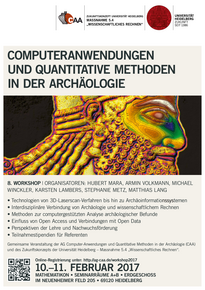
ZUK 5.4 Workshop
"CAA17 - Computeranwendungen und Quantitative Methoden in der Archäologie"
10. - 11. Februar 2017
Themen:
- Technologien von 3D-Laserscan-Verfahren bis hin zu Archäoinformationssystemen
- Interdisziplinäre Verbindung von Archäologie und wissenschaftlichem Rechnen
- Methoden zur computergestützten Analyse archäologischer Befunde
- Einfluss von Open Access und Verbindungen mit Open Data
- Perspektiven der Lehre und Nachwuchsförderung
Keynote:
- Prof. Reinhard Förtsch, Deutsches Archäologisches Institut (DAI)
Gemeinsame Veranstaltung der AG Computer-Anwendungen und Quantitative Methoden in der Archäologie (CAA) und des Zukunftskonzepts der Universität Heidelberg – Massnahme 5.4 „Wissenschaftliches Rechnen“.
Veranstaltungsort: Mathematikon • Seminarräume A+B & Hörsaal • Im Neuenheimer Feld 205 · 69120 Heidelberg
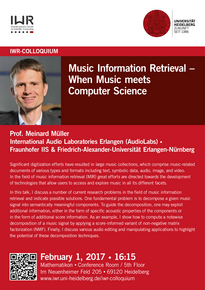
IWR-Colloquium Winter Term 2016 / 2017
"Music Information Retrieval - When Music meets Computer Science"
Prof. Meinard Müller • International Audio Laboratories Erlangen (AudioLabs), Fraunhofer IIS & Friedrich-Alexander-Universität Erlangen-Nürnberg
February 1, 2017 • 16:15
Significant digitization efforts have resulted in large music collections, which comprise music-related documents of various types and formats including text, symbolic data, audio, image, and video. In the field of music information retrieval (MIR) great efforts are directed towards the development of technologies that allow users to access and explore music in all its different facets. For example, during playback of some CD recording, a digital music player may present the corresponding musical score while highlighting the current playback position within the score. On demand, additional information about melodic and harmonic progression or rhythm and tempo is automatically presented to the listener. A suitable user interface displays the musical structure of the current piece of music and allows the user to directly jump to any key part within the recording without tedious fast-forwarding and rewinding. In this talk, I discuss a number of current research problems in the field of music information retrieval and indicate possible solutions. One fundamental problem is to decompose a given music signal into semantically meaningful components. To guide the decomposition, one may exploit additional information, either in the form of specific acoustic properties of the components or in the form of additional score information. As an example, I show how to compute a notewise decomposition of a music signal by applying a score-informed variant of non-negative matrix factorization (NMF). Finally, I discuss various audio editing and manipulating applications to highlight the potential of these decomposition techniques.
Location: Mathematikon • Conference Room / 5th Floor • Im Neuenheimer Feld 205 • 69120 Heidelberg

IWR-Colloquium Winter Term 2016 / 2017
"Finite dimensional state representation of linear and nonlinear delay systems"
Prof. Mats Gyllenberg • University of Helsinki, Finland
January 11, 2017 • 16:15
We consider the question of when delay systems, which are intrinsically infinite dimensional, can be represented by finite dimensional systems. Specifically, we give conditions for when all the information about the solutions of the delay system can be obtained from the solutions of a finite system of ordinary differential equations. For linear autonomous systems and linear systems with time-dependent input we give necessary and sufficient conditions and in the nonlinear case we give sufficient conditions. The ideas and results are illustrated by models for infectious diseases and physiologically structured populations.
Location: Mathematikon • Conference Room / 5th Floor • Im Neuenheimer Feld 205 • 69120 Heidelberg